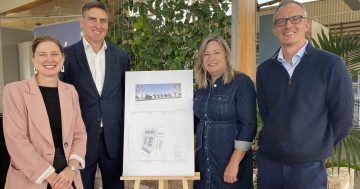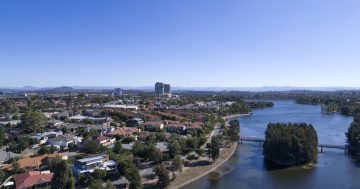
First-home buyers are increasingly looking to apartments like these in Belconnen. Photo: Geocon.
Rising prices and then interest rate hikes hit housing affordability in the ACT over the 2021-22 financial year, but first home buyers seem undeterred, determined to escape Canberra’s cruel rental market.
The Real Estate Institute of Australia’s Housing Affordability Report for the June quarter shows affordability for buyers and renters continued to worsen as lack of supply and surging interest rates impacted home ownership and tenancies.
REIA president Hayden Groves said the results for the June quarter showed lack of supply was the number-one key concern and that affordability would continue to worsen without state and federal government action.
In the ACT, the proportion of family income devoted to meeting average loan repayments increased to 28.2 per cent over the quarter, up 1.7 percentage points from the previous quarter.
Over the year, ACT homeowners shelled out 3.1 percentage points more for their repayments.
For those renting, the proportion of family income required to meet median rent increased to 21.9 per cent, an increase of 0.4 percentage points over the quarter and 1.4 percentage points over the year.
The ACT’s relatively high average incomes continued to support the market, with the Territory recording the highest increase in the number of loans to first home buyers.
Loan amounts rose 4.6 per cent over the year, but in the June quarter, they fell 5.1 per cent to an average of $500,462 as interest rate rises began to bite and first home buyers shifted their attention to cheaper medium and high-density properties.
The average loan size shrank 9.4 per cent over the year to $604,094.

A planned Build to Rent site in Dickson but development is still a long way off. Photo: CBRE Canberra.
REIACT CEO Michelle Tynan said spring had brought out more first home buyers, but they had adjusted their budgets to pursue cheaper properties, particularly units.
She said there was more stock available now than a year ago, but supply remained an issue for the ACT, like the rest of the country,
“We’re probably heading into our fifth year of undersupply in terms of actual land release and everything else that goes with it,” she said.
“But in terms of established stock, we’ve also seen a shortage of that over the last two or three years.”
Ms Tynan said that while auction clearance rates were down, properties were still selling, but without the “fear of missing out” that had driven the market during COVID.
Vendors were also adjusting their expectations, but Ms Tynan did not expect to see any dramatic fall in prices in Canberra.
For renters, the situation remains grim, with the latest SQM Research data for August showing a vacancy rate of just 0.9 per cent and the number of available properties falling from 675 in July to 633.
Rents continued to rise in August to an average of $660 a week, up 0.8 per cent on July and 10.8 per cent over the year.
For the week ending 12 September, the average rent for a three-bedroom house (if you can find one) was $700 a week, up 1.4 per cent on the month and 7.3 per cent over the year.
Renters were paying an average of $578 a week for units, up 0.6 per cent for the month and nearly 13 per cent over the year.
In the last seven years, rents overall have risen nearly 8 per cent a year.
Ms Tynan said the ACT Government’s tenancy bill changes giving renters more rights would only make matter worse, with landlords rethinking their investment options despite the big rental yields.
“We’ve done a survey through the Institute and there are a lot of investors out there that feel that the changes that are coming forward just simply make them unsustainable in the Canberra market in terms of upgrade costs and restriction, in the removal of no-cause terminations, “she said.
“Some landlords just feel that it’s not profitable anymore. It’s just getting too hard and messy … it’s far easier to sell and invest elsewhere.”
Ms Tynan said there needed to be a national discussion about social housing and the long-term rental needs of people, particularly as more rent for longer periods or do not become homeowners.
She said there were now more than 3000 people waiting for social housing and that would only get worse as more people are priced out of the market.
The government’s 15 per cent affordable housing component in new developments was not enough to make a dent, and while the Build to Rent idea showed promise those kinds of projects were still a long way off.
Ms Tynan said there needed to be available development sites and accompanying infrastructure sites for projects to succeed, as well as a community conversation about their acceptance in neighbourhoods, as well as infill and a loss of green space.




















